Food Safety Management Report: Prezzo Restaurant Analysis, HND
VerifiedAdded on 2020/11/23
|11
|3573
|364
Report
AI Summary
This report delves into the critical aspects of food safety management, focusing on the Italian restaurant chain, Prezzo. It begins with an introduction to food safety principles and then explores the categorization of food spoilage agents, detailing the impact of microbial and physical agents. The report then examines various food preservation methods, including fermenting, pasteurization, and irradiation, evaluating their effectiveness. A significant portion is dedicated to temperature control systems, outlining key steps in storage, cooling, cooking, defrosting, and service, alongside safe food storage methods like canning, drying, and freezing. The importance of personal hygiene, cleaning, and disinfection in preventing food contamination is also discussed. Furthermore, the report assesses problems associated with pest control, justifies the need for hygienic design and construction of food premises, and emphasizes the importance of training as a quality assurance mechanism. Finally, the report includes a food hazard risk assessment, completes a food safety control system, and devises a food safety guide for legislation compliance, culminating in a comprehensive overview of food safety practices within the hospitality industry.
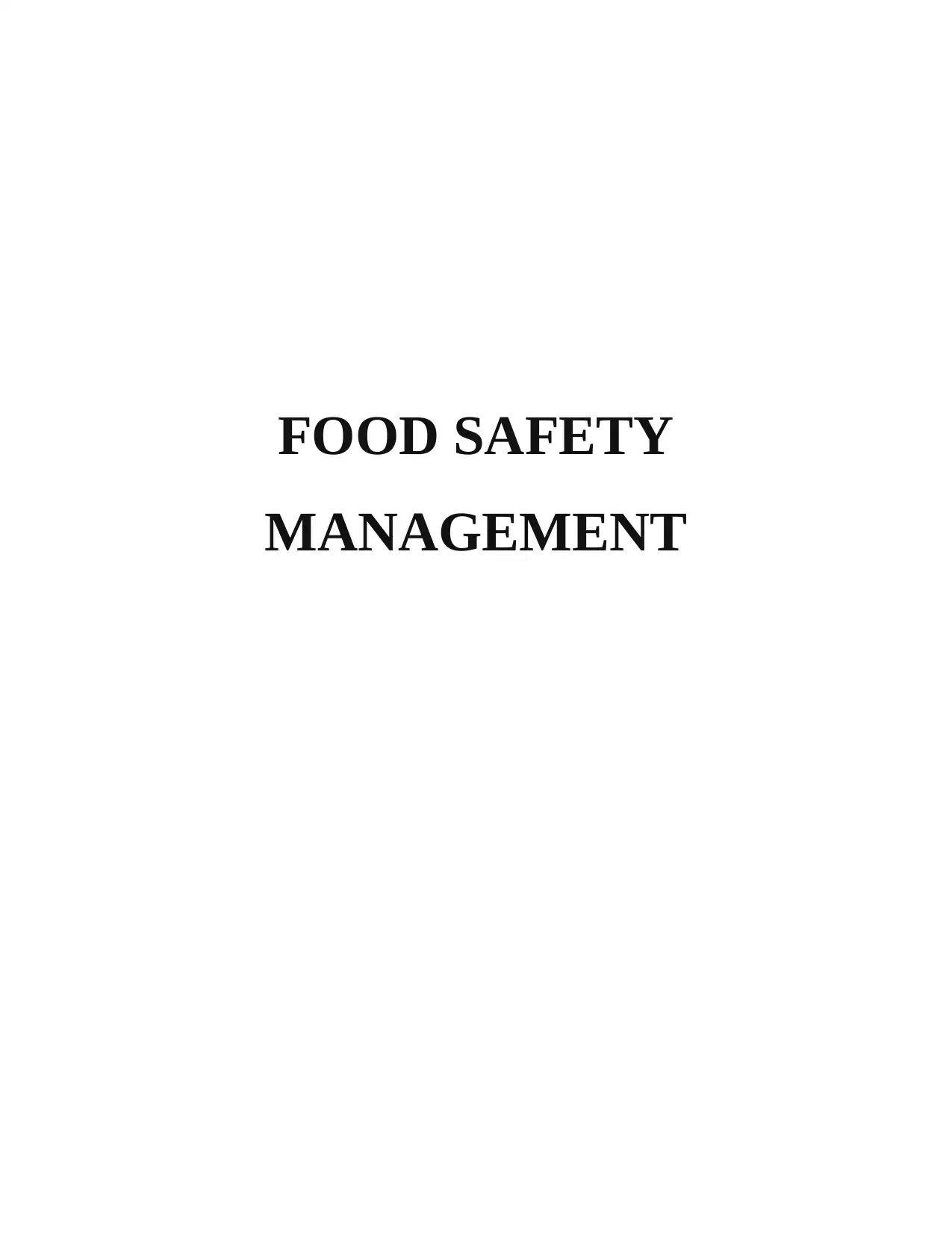
FOOD SAFETY
MANAGEMENT
MANAGEMENT
Paraphrase This Document
Need a fresh take? Get an instant paraphrase of this document with our AI Paraphraser
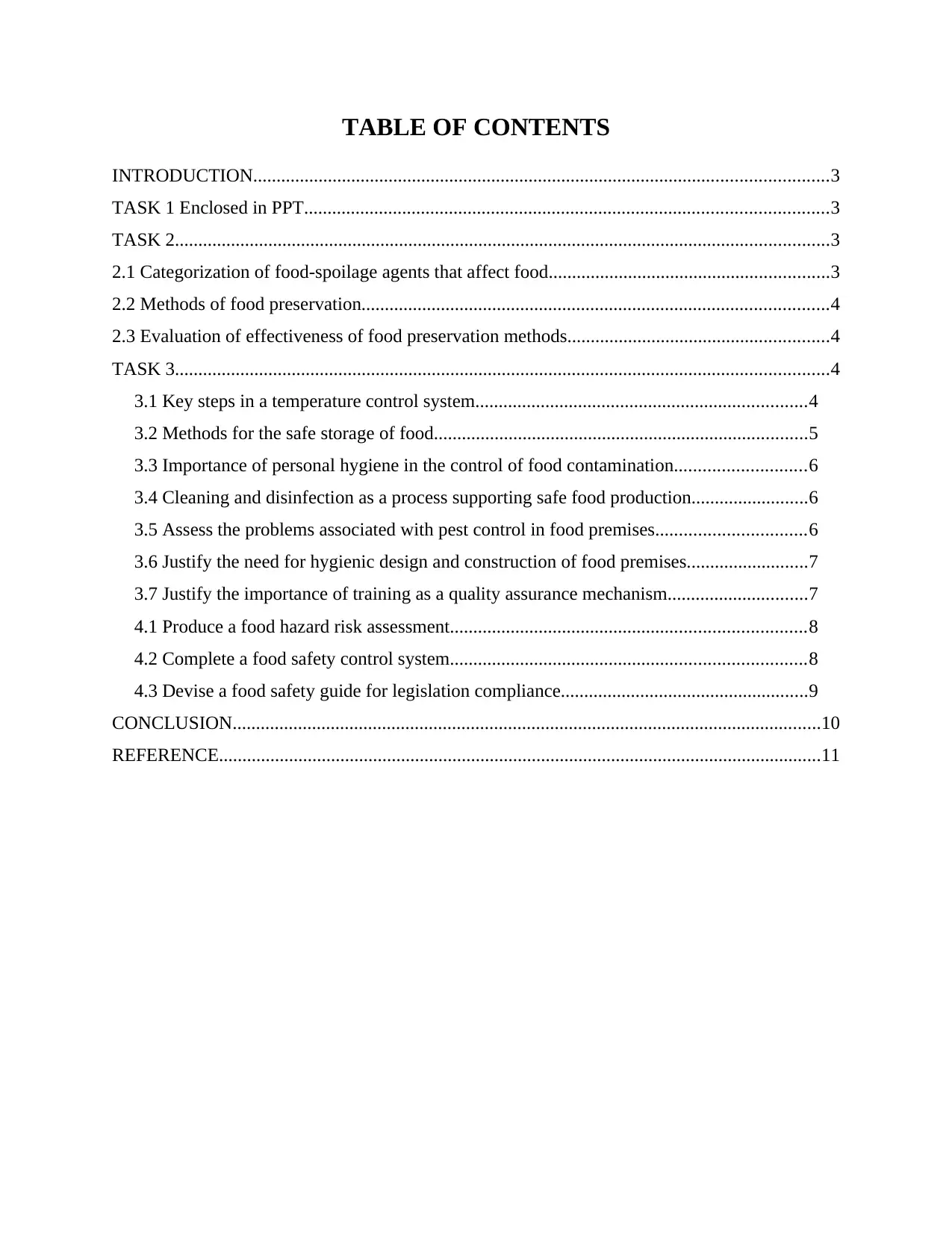
TABLE OF CONTENTS
INTRODUCTION...........................................................................................................................3
TASK 1 Enclosed in PPT................................................................................................................3
TASK 2............................................................................................................................................3
2.1 Categorization of food-spoilage agents that affect food............................................................3
2.2 Methods of food preservation....................................................................................................4
2.3 Evaluation of effectiveness of food preservation methods........................................................4
TASK 3............................................................................................................................................4
3.1 Key steps in a temperature control system.......................................................................4
3.2 Methods for the safe storage of food................................................................................5
3.3 Importance of personal hygiene in the control of food contamination............................6
3.4 Cleaning and disinfection as a process supporting safe food production.........................6
3.5 Assess the problems associated with pest control in food premises................................6
3.6 Justify the need for hygienic design and construction of food premises..........................7
3.7 Justify the importance of training as a quality assurance mechanism..............................7
4.1 Produce a food hazard risk assessment............................................................................8
4.2 Complete a food safety control system............................................................................8
4.3 Devise a food safety guide for legislation compliance.....................................................9
CONCLUSION..............................................................................................................................10
REFERENCE.................................................................................................................................11
INTRODUCTION...........................................................................................................................3
TASK 1 Enclosed in PPT................................................................................................................3
TASK 2............................................................................................................................................3
2.1 Categorization of food-spoilage agents that affect food............................................................3
2.2 Methods of food preservation....................................................................................................4
2.3 Evaluation of effectiveness of food preservation methods........................................................4
TASK 3............................................................................................................................................4
3.1 Key steps in a temperature control system.......................................................................4
3.2 Methods for the safe storage of food................................................................................5
3.3 Importance of personal hygiene in the control of food contamination............................6
3.4 Cleaning and disinfection as a process supporting safe food production.........................6
3.5 Assess the problems associated with pest control in food premises................................6
3.6 Justify the need for hygienic design and construction of food premises..........................7
3.7 Justify the importance of training as a quality assurance mechanism..............................7
4.1 Produce a food hazard risk assessment............................................................................8
4.2 Complete a food safety control system............................................................................8
4.3 Devise a food safety guide for legislation compliance.....................................................9
CONCLUSION..............................................................................................................................10
REFERENCE.................................................................................................................................11

INTRODUCTION
Food safety and management is the foremost function of any food production settings.
Safety of food and its management need certain compliance of different protocols that helps in
maintaining processes related to food preparation process and cleanliness factors. The study has
undertaken Prezzo, an Italian chain of restaurant in UK established in year 2000 to relate the
facts mentioned in study. This report will highlight some basic description to food related
problems and various methods to keep a food producing area clean, standardized. It will also
include a description of food safety laws that are adopted by restaurants to manage quality of
services.
The study will enclose some methods of food preservation and its effectiveness with the
importance of temperature control systems within a restaurant. The study will cover significance
of cleanliness, training, personal hygiene and hygenic design and construction for food
preparation.
TASK 1 Enclosed in PPT
TASK 2
2.1 Categorization of food-spoilage agents that affect food
Food spoilage is a process that disturbs or deteriorates and destruct healthy contents of
food products. It occurs by action of external bodies that spoils food contents and making it
harmful for consumption.
Food spoilage agents Food they affect
Microbial agents are different bacteria, virus or microbes that spoil
basic content of food items and make it harmful for human
consumption.
Milk, Fruits,
Vegetables, Breads etc.
Physical agents are mainly food distributors, animals and other bodies
that damage covering of food items like any fruit and vegetables. This
damages its color
Wheat, grains, fruits,
vegetables,
Food safety and management is the foremost function of any food production settings.
Safety of food and its management need certain compliance of different protocols that helps in
maintaining processes related to food preparation process and cleanliness factors. The study has
undertaken Prezzo, an Italian chain of restaurant in UK established in year 2000 to relate the
facts mentioned in study. This report will highlight some basic description to food related
problems and various methods to keep a food producing area clean, standardized. It will also
include a description of food safety laws that are adopted by restaurants to manage quality of
services.
The study will enclose some methods of food preservation and its effectiveness with the
importance of temperature control systems within a restaurant. The study will cover significance
of cleanliness, training, personal hygiene and hygenic design and construction for food
preparation.
TASK 1 Enclosed in PPT
TASK 2
2.1 Categorization of food-spoilage agents that affect food
Food spoilage is a process that disturbs or deteriorates and destruct healthy contents of
food products. It occurs by action of external bodies that spoils food contents and making it
harmful for consumption.
Food spoilage agents Food they affect
Microbial agents are different bacteria, virus or microbes that spoil
basic content of food items and make it harmful for human
consumption.
Milk, Fruits,
Vegetables, Breads etc.
Physical agents are mainly food distributors, animals and other bodies
that damage covering of food items like any fruit and vegetables. This
damages its color
Wheat, grains, fruits,
vegetables,
⊘ This is a preview!⊘
Do you want full access?
Subscribe today to unlock all pages.

Trusted by 1+ million students worldwide

2.2 Methods of food preservation
Mangers of larger restaurants like Prezzo, undergo for different food preservation
methods depending upon the nature, temperature of area and other related components (Marriott,
Schilling and Gravani, 2018). Different food preservation methods are as follows:
Fermenting: It is the process of preserving food adding yeasts and other bacteria at
standardized conditions. It is used to preserve food items containing sugar.
Pasteurization: This method is commonly used to preserve liquid items such as milk,
Juices, ice creams, beers etc (Manning, 2018). It includes boiling the items at considerably
extreme temperature and introducing certain enzymes to maintain the taste of products.
Irradiation: It is a modern method of preserving food items by adding or introducing
food items to different radiations like X-rays, Gamma- rays and radioactive substances to
increase the life of food products. It is an expensive methodology to perform and generally do
not adopted by restaurants or small scale food industry.
2.3 Evaluation of effectiveness of food preservation methods
Food preservation is a process of storing food items with the help of certain
additives that increases life span of food and safeguard its nutrients. All above mentioned
food preservation methods have certain effectiveness-
Fermenting It does not affect the taste of preserved items. Level of nutrients remain same.
Fermentation by lactic acids is helpful for digestive functions.
Pasteurization Pasteurization is one of the oldest, cheapest method of food preservation. It
reduces the risk of different illnesses like tuberculosis. It increases the level of
cleanliness specially during preparation of milk products.
Irradiation Irradiation reduces the amount of virus, bacteria and internal harmful microbes
by the application of high temperature of radiations. It does not affect the
natural level of healthy contents within food items.
TASK 3
3.1 Key steps in a temperature control system
Temperature control systems inhibits specific temperature settings for performing the
process of storing, cooking, cooling or heating the food items (Weller, 2018). Every restaurants
Mangers of larger restaurants like Prezzo, undergo for different food preservation
methods depending upon the nature, temperature of area and other related components (Marriott,
Schilling and Gravani, 2018). Different food preservation methods are as follows:
Fermenting: It is the process of preserving food adding yeasts and other bacteria at
standardized conditions. It is used to preserve food items containing sugar.
Pasteurization: This method is commonly used to preserve liquid items such as milk,
Juices, ice creams, beers etc (Manning, 2018). It includes boiling the items at considerably
extreme temperature and introducing certain enzymes to maintain the taste of products.
Irradiation: It is a modern method of preserving food items by adding or introducing
food items to different radiations like X-rays, Gamma- rays and radioactive substances to
increase the life of food products. It is an expensive methodology to perform and generally do
not adopted by restaurants or small scale food industry.
2.3 Evaluation of effectiveness of food preservation methods
Food preservation is a process of storing food items with the help of certain
additives that increases life span of food and safeguard its nutrients. All above mentioned
food preservation methods have certain effectiveness-
Fermenting It does not affect the taste of preserved items. Level of nutrients remain same.
Fermentation by lactic acids is helpful for digestive functions.
Pasteurization Pasteurization is one of the oldest, cheapest method of food preservation. It
reduces the risk of different illnesses like tuberculosis. It increases the level of
cleanliness specially during preparation of milk products.
Irradiation Irradiation reduces the amount of virus, bacteria and internal harmful microbes
by the application of high temperature of radiations. It does not affect the
natural level of healthy contents within food items.
TASK 3
3.1 Key steps in a temperature control system
Temperature control systems inhibits specific temperature settings for performing the
process of storing, cooking, cooling or heating the food items (Weller, 2018). Every restaurants
Paraphrase This Document
Need a fresh take? Get an instant paraphrase of this document with our AI Paraphraser
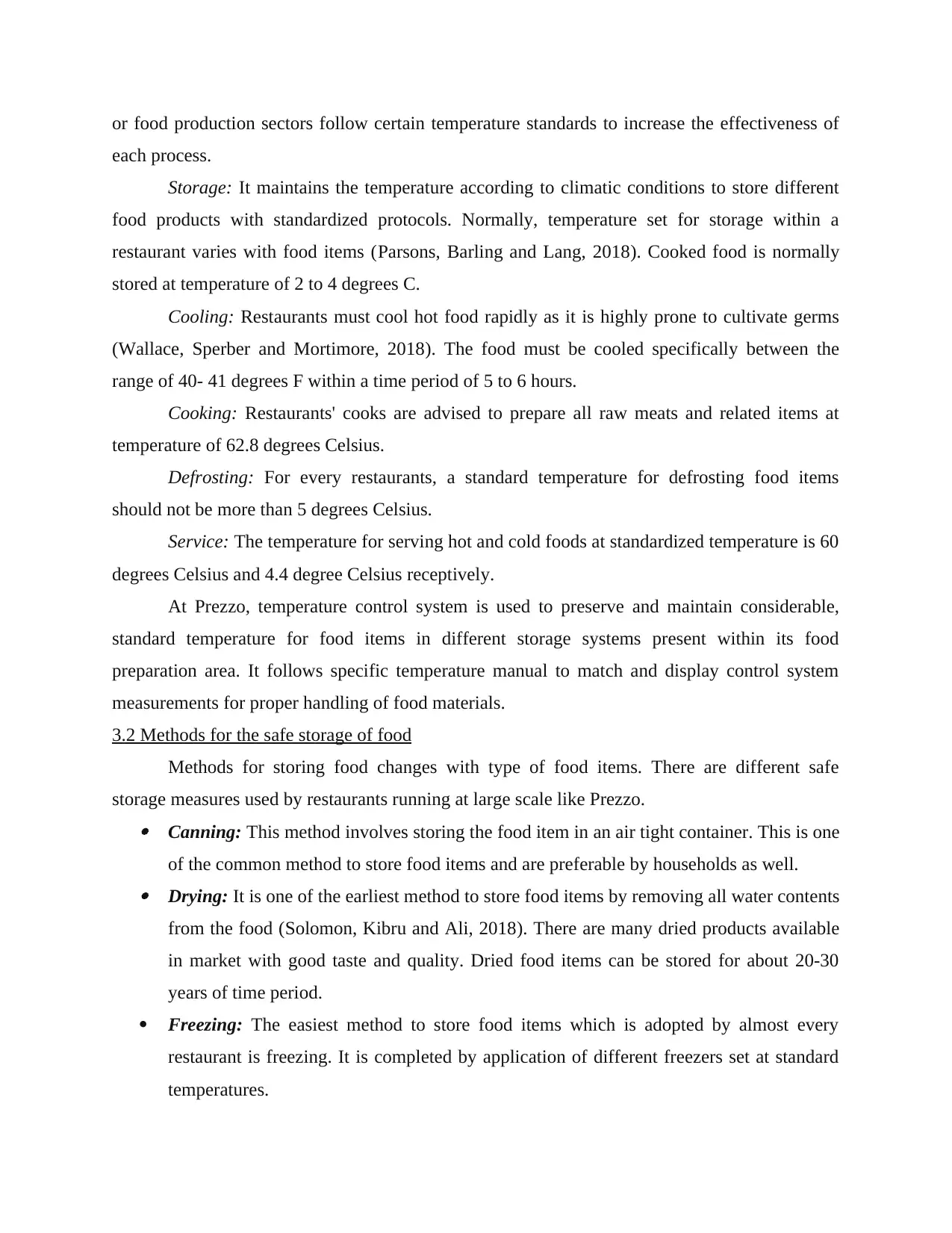
or food production sectors follow certain temperature standards to increase the effectiveness of
each process.
Storage: It maintains the temperature according to climatic conditions to store different
food products with standardized protocols. Normally, temperature set for storage within a
restaurant varies with food items (Parsons, Barling and Lang, 2018). Cooked food is normally
stored at temperature of 2 to 4 degrees C.
Cooling: Restaurants must cool hot food rapidly as it is highly prone to cultivate germs
(Wallace, Sperber and Mortimore, 2018). The food must be cooled specifically between the
range of 40- 41 degrees F within a time period of 5 to 6 hours.
Cooking: Restaurants' cooks are advised to prepare all raw meats and related items at
temperature of 62.8 degrees Celsius.
Defrosting: For every restaurants, a standard temperature for defrosting food items
should not be more than 5 degrees Celsius.
Service: The temperature for serving hot and cold foods at standardized temperature is 60
degrees Celsius and 4.4 degree Celsius receptively.
At Prezzo, temperature control system is used to preserve and maintain considerable,
standard temperature for food items in different storage systems present within its food
preparation area. It follows specific temperature manual to match and display control system
measurements for proper handling of food materials.
3.2 Methods for the safe storage of food
Methods for storing food changes with type of food items. There are different safe
storage measures used by restaurants running at large scale like Prezzo. Canning: This method involves storing the food item in an air tight container. This is one
of the common method to store food items and are preferable by households as well. Drying: It is one of the earliest method to store food items by removing all water contents
from the food (Solomon, Kibru and Ali, 2018). There are many dried products available
in market with good taste and quality. Dried food items can be stored for about 20-30
years of time period.
Freezing: The easiest method to store food items which is adopted by almost every
restaurant is freezing. It is completed by application of different freezers set at standard
temperatures.
each process.
Storage: It maintains the temperature according to climatic conditions to store different
food products with standardized protocols. Normally, temperature set for storage within a
restaurant varies with food items (Parsons, Barling and Lang, 2018). Cooked food is normally
stored at temperature of 2 to 4 degrees C.
Cooling: Restaurants must cool hot food rapidly as it is highly prone to cultivate germs
(Wallace, Sperber and Mortimore, 2018). The food must be cooled specifically between the
range of 40- 41 degrees F within a time period of 5 to 6 hours.
Cooking: Restaurants' cooks are advised to prepare all raw meats and related items at
temperature of 62.8 degrees Celsius.
Defrosting: For every restaurants, a standard temperature for defrosting food items
should not be more than 5 degrees Celsius.
Service: The temperature for serving hot and cold foods at standardized temperature is 60
degrees Celsius and 4.4 degree Celsius receptively.
At Prezzo, temperature control system is used to preserve and maintain considerable,
standard temperature for food items in different storage systems present within its food
preparation area. It follows specific temperature manual to match and display control system
measurements for proper handling of food materials.
3.2 Methods for the safe storage of food
Methods for storing food changes with type of food items. There are different safe
storage measures used by restaurants running at large scale like Prezzo. Canning: This method involves storing the food item in an air tight container. This is one
of the common method to store food items and are preferable by households as well. Drying: It is one of the earliest method to store food items by removing all water contents
from the food (Solomon, Kibru and Ali, 2018). There are many dried products available
in market with good taste and quality. Dried food items can be stored for about 20-30
years of time period.
Freezing: The easiest method to store food items which is adopted by almost every
restaurant is freezing. It is completed by application of different freezers set at standard
temperatures.
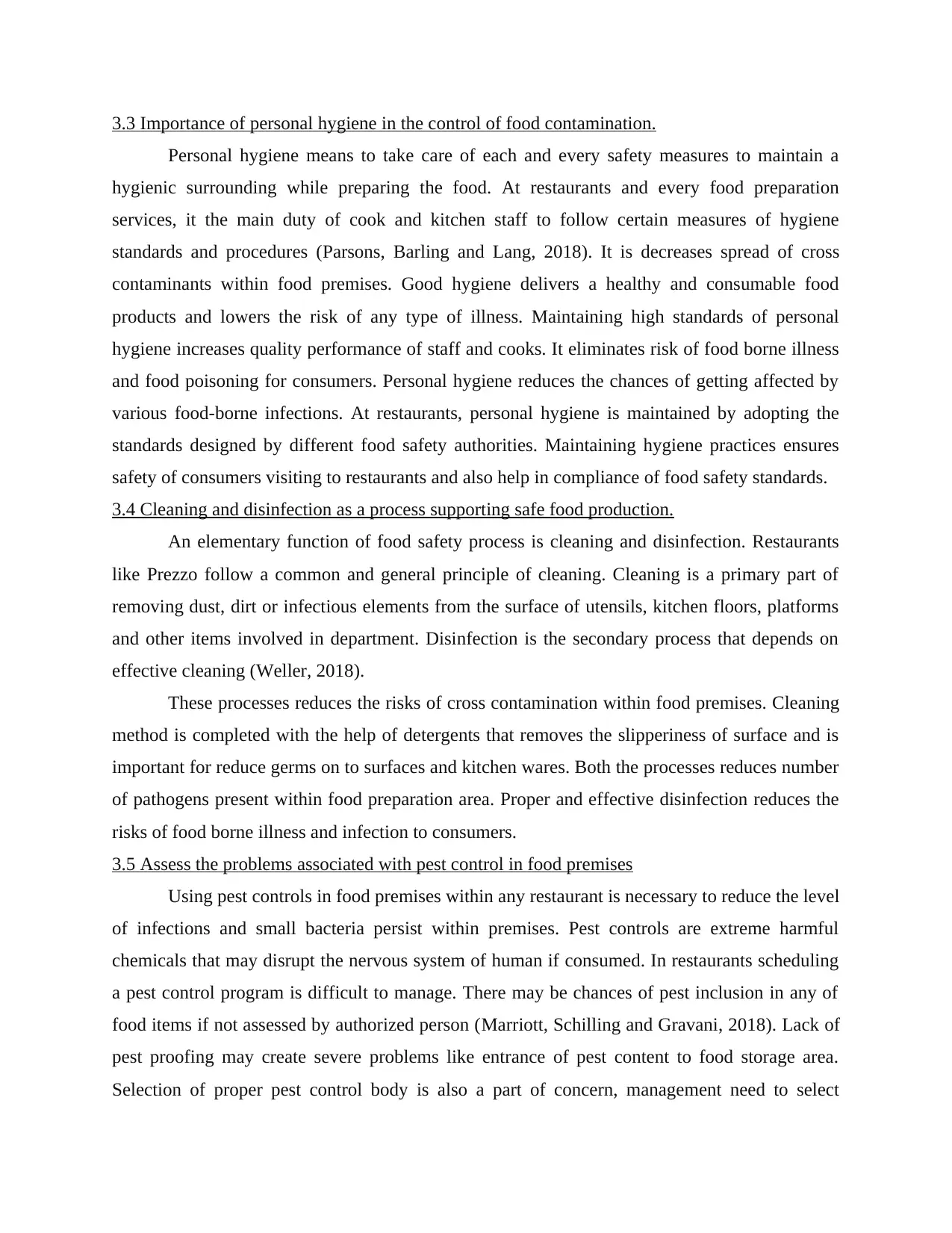
3.3 Importance of personal hygiene in the control of food contamination.
Personal hygiene means to take care of each and every safety measures to maintain a
hygienic surrounding while preparing the food. At restaurants and every food preparation
services, it the main duty of cook and kitchen staff to follow certain measures of hygiene
standards and procedures (Parsons, Barling and Lang, 2018). It is decreases spread of cross
contaminants within food premises. Good hygiene delivers a healthy and consumable food
products and lowers the risk of any type of illness. Maintaining high standards of personal
hygiene increases quality performance of staff and cooks. It eliminates risk of food borne illness
and food poisoning for consumers. Personal hygiene reduces the chances of getting affected by
various food-borne infections. At restaurants, personal hygiene is maintained by adopting the
standards designed by different food safety authorities. Maintaining hygiene practices ensures
safety of consumers visiting to restaurants and also help in compliance of food safety standards.
3.4 Cleaning and disinfection as a process supporting safe food production.
An elementary function of food safety process is cleaning and disinfection. Restaurants
like Prezzo follow a common and general principle of cleaning. Cleaning is a primary part of
removing dust, dirt or infectious elements from the surface of utensils, kitchen floors, platforms
and other items involved in department. Disinfection is the secondary process that depends on
effective cleaning (Weller, 2018).
These processes reduces the risks of cross contamination within food premises. Cleaning
method is completed with the help of detergents that removes the slipperiness of surface and is
important for reduce germs on to surfaces and kitchen wares. Both the processes reduces number
of pathogens present within food preparation area. Proper and effective disinfection reduces the
risks of food borne illness and infection to consumers.
3.5 Assess the problems associated with pest control in food premises
Using pest controls in food premises within any restaurant is necessary to reduce the level
of infections and small bacteria persist within premises. Pest controls are extreme harmful
chemicals that may disrupt the nervous system of human if consumed. In restaurants scheduling
a pest control program is difficult to manage. There may be chances of pest inclusion in any of
food items if not assessed by authorized person (Marriott, Schilling and Gravani, 2018). Lack of
pest proofing may create severe problems like entrance of pest content to food storage area.
Selection of proper pest control body is also a part of concern, management need to select
Personal hygiene means to take care of each and every safety measures to maintain a
hygienic surrounding while preparing the food. At restaurants and every food preparation
services, it the main duty of cook and kitchen staff to follow certain measures of hygiene
standards and procedures (Parsons, Barling and Lang, 2018). It is decreases spread of cross
contaminants within food premises. Good hygiene delivers a healthy and consumable food
products and lowers the risk of any type of illness. Maintaining high standards of personal
hygiene increases quality performance of staff and cooks. It eliminates risk of food borne illness
and food poisoning for consumers. Personal hygiene reduces the chances of getting affected by
various food-borne infections. At restaurants, personal hygiene is maintained by adopting the
standards designed by different food safety authorities. Maintaining hygiene practices ensures
safety of consumers visiting to restaurants and also help in compliance of food safety standards.
3.4 Cleaning and disinfection as a process supporting safe food production.
An elementary function of food safety process is cleaning and disinfection. Restaurants
like Prezzo follow a common and general principle of cleaning. Cleaning is a primary part of
removing dust, dirt or infectious elements from the surface of utensils, kitchen floors, platforms
and other items involved in department. Disinfection is the secondary process that depends on
effective cleaning (Weller, 2018).
These processes reduces the risks of cross contamination within food premises. Cleaning
method is completed with the help of detergents that removes the slipperiness of surface and is
important for reduce germs on to surfaces and kitchen wares. Both the processes reduces number
of pathogens present within food preparation area. Proper and effective disinfection reduces the
risks of food borne illness and infection to consumers.
3.5 Assess the problems associated with pest control in food premises
Using pest controls in food premises within any restaurant is necessary to reduce the level
of infections and small bacteria persist within premises. Pest controls are extreme harmful
chemicals that may disrupt the nervous system of human if consumed. In restaurants scheduling
a pest control program is difficult to manage. There may be chances of pest inclusion in any of
food items if not assessed by authorized person (Marriott, Schilling and Gravani, 2018). Lack of
pest proofing may create severe problems like entrance of pest content to food storage area.
Selection of proper pest control body is also a part of concern, management need to select
⊘ This is a preview!⊘
Do you want full access?
Subscribe today to unlock all pages.

Trusted by 1+ million students worldwide

efficient team of pest control for proper implementation of program. Supervisors faces problems
while checking cleaning procedures to its depth. Improper cleaning will not only create a risk of
health issues but also disrupts normal functioning of restaurants. Lack of training to staff for pest
storage also increases the problem related to its spillage. At Prezzo, pest management is
conducted under the application and guidelines of GMP. The restaurant take care of
environmental issues while implementing a pest control program.
3.6 Justify the need for hygienic design and construction of food premises.
Hygienic design and construction of food premises refers to specific building structures
that are considered specially for cooking area of any restaurant. Such designs and layouts should
be considered for any food preparation area to reduce infection, entrance of dirt, toxic materials
and other unwanted substances into the food premises. Hygienic design and considerations for
constructing kitchen area provides uninterrupted working system to staff. It also provides
systematic functioning of kitchen activities. Proper outlet eliminates risk of slips and falls food
premises (Solomon, Kibru and Ali, 2018). Maintenance of dryness within whole area to
eliminate the development of bacteria. Proper construction of corners of the premises do not let
dust to get accumulated. Selection of appropriate color and quality of paints decreases chances of
peeling or cracked paints and hence reduces physical contamination of food items and
contaminate it. Piping systems, painted iron materials, concrete and non slippery floors all
measures delivery appropriate working patters to staff.
3.7 Justify the importance of training as a quality assurance mechanism
For maintaining high level of quality in each food preparation or manufacturing
procedures, it is important to train involved staff regarding various aspects of food preparations.
Provision of quality assurance training for staff and different cooks within any restaurant setting
aware them about various standardized protocols for food preparation processes (Wallace,
Sperber and Mortimore, 2018). By quality assurance assessments at regular basis, staff would
know the importance of cleanliness, hand washing while preparing food. Different vocational
and education to staff make them familiar with various policies of standard operations.
Systematic audits and plans strengthen food handlers' effectiveness and productivity. It delivers
them high quality of working procedures with specified safety measures.
while checking cleaning procedures to its depth. Improper cleaning will not only create a risk of
health issues but also disrupts normal functioning of restaurants. Lack of training to staff for pest
storage also increases the problem related to its spillage. At Prezzo, pest management is
conducted under the application and guidelines of GMP. The restaurant take care of
environmental issues while implementing a pest control program.
3.6 Justify the need for hygienic design and construction of food premises.
Hygienic design and construction of food premises refers to specific building structures
that are considered specially for cooking area of any restaurant. Such designs and layouts should
be considered for any food preparation area to reduce infection, entrance of dirt, toxic materials
and other unwanted substances into the food premises. Hygienic design and considerations for
constructing kitchen area provides uninterrupted working system to staff. It also provides
systematic functioning of kitchen activities. Proper outlet eliminates risk of slips and falls food
premises (Solomon, Kibru and Ali, 2018). Maintenance of dryness within whole area to
eliminate the development of bacteria. Proper construction of corners of the premises do not let
dust to get accumulated. Selection of appropriate color and quality of paints decreases chances of
peeling or cracked paints and hence reduces physical contamination of food items and
contaminate it. Piping systems, painted iron materials, concrete and non slippery floors all
measures delivery appropriate working patters to staff.
3.7 Justify the importance of training as a quality assurance mechanism
For maintaining high level of quality in each food preparation or manufacturing
procedures, it is important to train involved staff regarding various aspects of food preparations.
Provision of quality assurance training for staff and different cooks within any restaurant setting
aware them about various standardized protocols for food preparation processes (Wallace,
Sperber and Mortimore, 2018). By quality assurance assessments at regular basis, staff would
know the importance of cleanliness, hand washing while preparing food. Different vocational
and education to staff make them familiar with various policies of standard operations.
Systematic audits and plans strengthen food handlers' effectiveness and productivity. It delivers
them high quality of working procedures with specified safety measures.
Paraphrase This Document
Need a fresh take? Get an instant paraphrase of this document with our AI Paraphraser
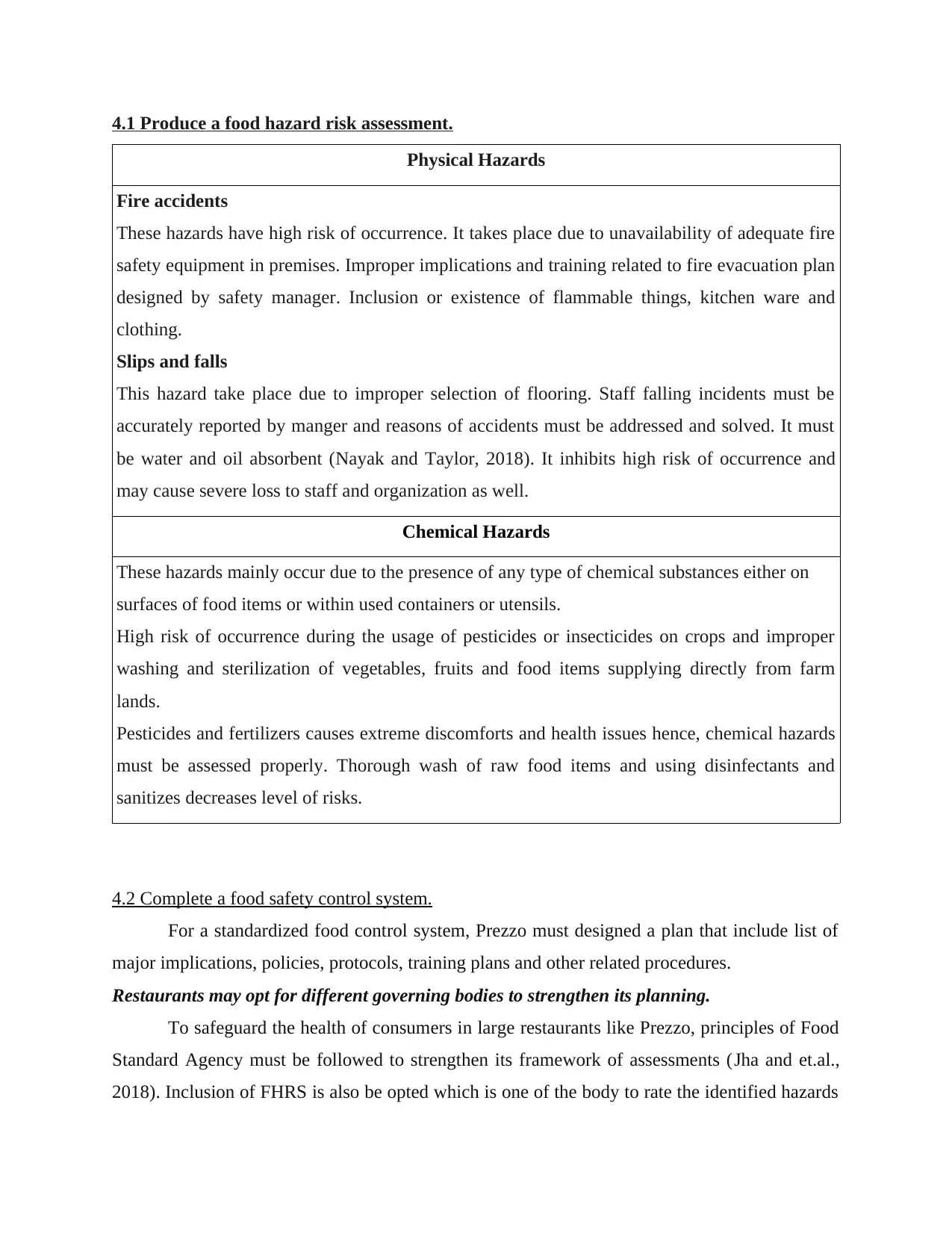
4.1 Produce a food hazard risk assessment.
Physical Hazards
Fire accidents
These hazards have high risk of occurrence. It takes place due to unavailability of adequate fire
safety equipment in premises. Improper implications and training related to fire evacuation plan
designed by safety manager. Inclusion or existence of flammable things, kitchen ware and
clothing.
Slips and falls
This hazard take place due to improper selection of flooring. Staff falling incidents must be
accurately reported by manger and reasons of accidents must be addressed and solved. It must
be water and oil absorbent (Nayak and Taylor, 2018). It inhibits high risk of occurrence and
may cause severe loss to staff and organization as well.
Chemical Hazards
These hazards mainly occur due to the presence of any type of chemical substances either on
surfaces of food items or within used containers or utensils.
High risk of occurrence during the usage of pesticides or insecticides on crops and improper
washing and sterilization of vegetables, fruits and food items supplying directly from farm
lands.
Pesticides and fertilizers causes extreme discomforts and health issues hence, chemical hazards
must be assessed properly. Thorough wash of raw food items and using disinfectants and
sanitizes decreases level of risks.
4.2 Complete a food safety control system.
For a standardized food control system, Prezzo must designed a plan that include list of
major implications, policies, protocols, training plans and other related procedures.
Restaurants may opt for different governing bodies to strengthen its planning.
To safeguard the health of consumers in large restaurants like Prezzo, principles of Food
Standard Agency must be followed to strengthen its framework of assessments (Jha and et.al.,
2018). Inclusion of FHRS is also be opted which is one of the body to rate the identified hazards
Physical Hazards
Fire accidents
These hazards have high risk of occurrence. It takes place due to unavailability of adequate fire
safety equipment in premises. Improper implications and training related to fire evacuation plan
designed by safety manager. Inclusion or existence of flammable things, kitchen ware and
clothing.
Slips and falls
This hazard take place due to improper selection of flooring. Staff falling incidents must be
accurately reported by manger and reasons of accidents must be addressed and solved. It must
be water and oil absorbent (Nayak and Taylor, 2018). It inhibits high risk of occurrence and
may cause severe loss to staff and organization as well.
Chemical Hazards
These hazards mainly occur due to the presence of any type of chemical substances either on
surfaces of food items or within used containers or utensils.
High risk of occurrence during the usage of pesticides or insecticides on crops and improper
washing and sterilization of vegetables, fruits and food items supplying directly from farm
lands.
Pesticides and fertilizers causes extreme discomforts and health issues hence, chemical hazards
must be assessed properly. Thorough wash of raw food items and using disinfectants and
sanitizes decreases level of risks.
4.2 Complete a food safety control system.
For a standardized food control system, Prezzo must designed a plan that include list of
major implications, policies, protocols, training plans and other related procedures.
Restaurants may opt for different governing bodies to strengthen its planning.
To safeguard the health of consumers in large restaurants like Prezzo, principles of Food
Standard Agency must be followed to strengthen its framework of assessments (Jha and et.al.,
2018). Inclusion of FHRS is also be opted which is one of the body to rate the identified hazards
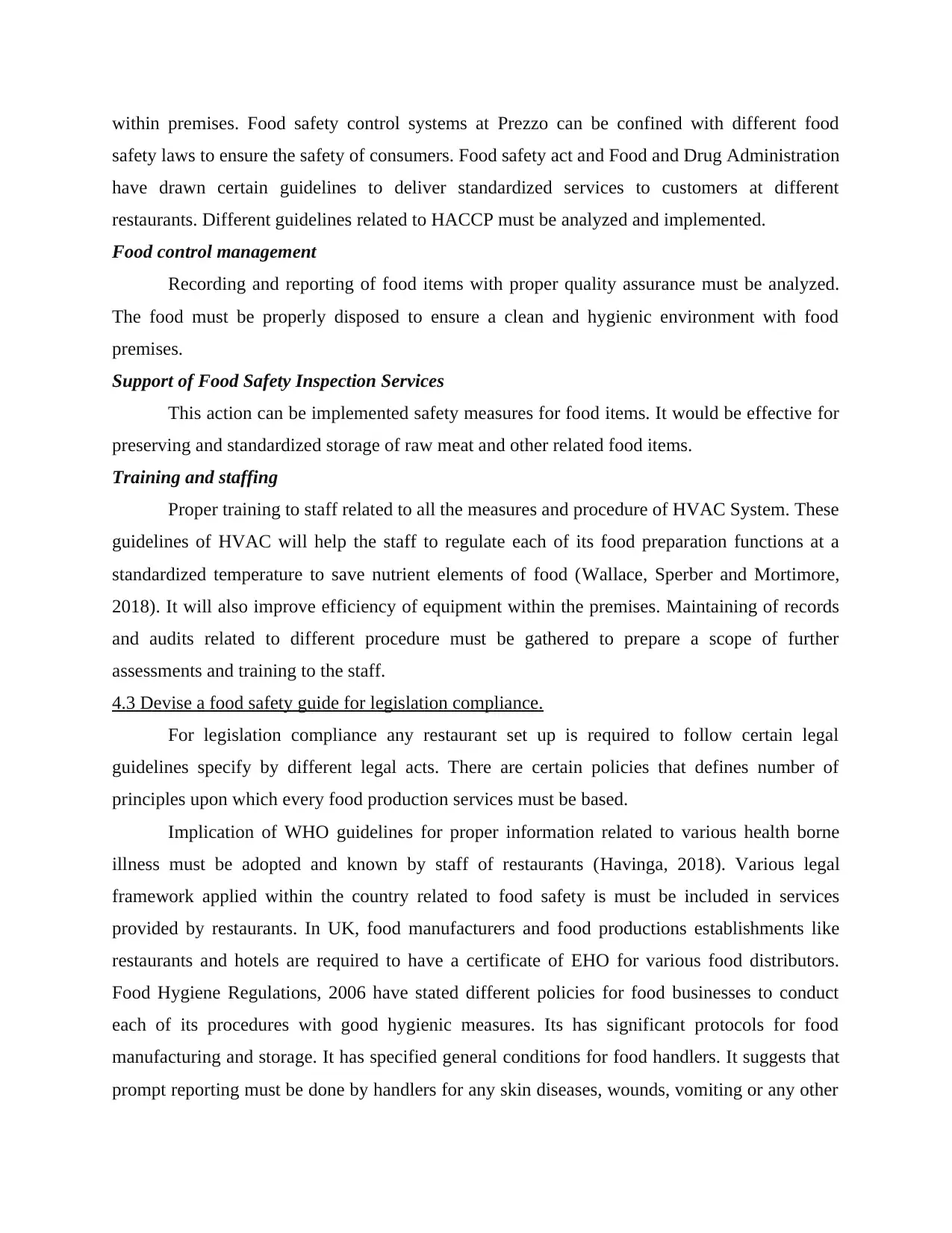
within premises. Food safety control systems at Prezzo can be confined with different food
safety laws to ensure the safety of consumers. Food safety act and Food and Drug Administration
have drawn certain guidelines to deliver standardized services to customers at different
restaurants. Different guidelines related to HACCP must be analyzed and implemented.
Food control management
Recording and reporting of food items with proper quality assurance must be analyzed.
The food must be properly disposed to ensure a clean and hygienic environment with food
premises.
Support of Food Safety Inspection Services
This action can be implemented safety measures for food items. It would be effective for
preserving and standardized storage of raw meat and other related food items.
Training and staffing
Proper training to staff related to all the measures and procedure of HVAC System. These
guidelines of HVAC will help the staff to regulate each of its food preparation functions at a
standardized temperature to save nutrient elements of food (Wallace, Sperber and Mortimore,
2018). It will also improve efficiency of equipment within the premises. Maintaining of records
and audits related to different procedure must be gathered to prepare a scope of further
assessments and training to the staff.
4.3 Devise a food safety guide for legislation compliance.
For legislation compliance any restaurant set up is required to follow certain legal
guidelines specify by different legal acts. There are certain policies that defines number of
principles upon which every food production services must be based.
Implication of WHO guidelines for proper information related to various health borne
illness must be adopted and known by staff of restaurants (Havinga, 2018). Various legal
framework applied within the country related to food safety is must be included in services
provided by restaurants. In UK, food manufacturers and food productions establishments like
restaurants and hotels are required to have a certificate of EHO for various food distributors.
Food Hygiene Regulations, 2006 have stated different policies for food businesses to conduct
each of its procedures with good hygienic measures. Its has significant protocols for food
manufacturing and storage. It has specified general conditions for food handlers. It suggests that
prompt reporting must be done by handlers for any skin diseases, wounds, vomiting or any other
safety laws to ensure the safety of consumers. Food safety act and Food and Drug Administration
have drawn certain guidelines to deliver standardized services to customers at different
restaurants. Different guidelines related to HACCP must be analyzed and implemented.
Food control management
Recording and reporting of food items with proper quality assurance must be analyzed.
The food must be properly disposed to ensure a clean and hygienic environment with food
premises.
Support of Food Safety Inspection Services
This action can be implemented safety measures for food items. It would be effective for
preserving and standardized storage of raw meat and other related food items.
Training and staffing
Proper training to staff related to all the measures and procedure of HVAC System. These
guidelines of HVAC will help the staff to regulate each of its food preparation functions at a
standardized temperature to save nutrient elements of food (Wallace, Sperber and Mortimore,
2018). It will also improve efficiency of equipment within the premises. Maintaining of records
and audits related to different procedure must be gathered to prepare a scope of further
assessments and training to the staff.
4.3 Devise a food safety guide for legislation compliance.
For legislation compliance any restaurant set up is required to follow certain legal
guidelines specify by different legal acts. There are certain policies that defines number of
principles upon which every food production services must be based.
Implication of WHO guidelines for proper information related to various health borne
illness must be adopted and known by staff of restaurants (Havinga, 2018). Various legal
framework applied within the country related to food safety is must be included in services
provided by restaurants. In UK, food manufacturers and food productions establishments like
restaurants and hotels are required to have a certificate of EHO for various food distributors.
Food Hygiene Regulations, 2006 have stated different policies for food businesses to conduct
each of its procedures with good hygienic measures. Its has significant protocols for food
manufacturing and storage. It has specified general conditions for food handlers. It suggests that
prompt reporting must be done by handlers for any skin diseases, wounds, vomiting or any other
⊘ This is a preview!⊘
Do you want full access?
Subscribe today to unlock all pages.

Trusted by 1+ million students worldwide

discomfort. Food businesses within UK are bound with certain risk management assessments
that must be analyzed by Hazards Analysis of Critical Control Points for proper management of
whole assessing processes (Dina and Manuel, 2018).
All the restaurants in UK at large scale like Prezzo has to bound their services with
specified legal framework related to food safety, production and handling measures. They need
to confined their training assessment based on the legal principles delivered by HACCP. These
legal standards have delivered a proper structure to food businesses of UK and inclusion of
different policies have generated adequate quality of services.
CONCLUSION
The report has suggested that food production industries or restaurants can take a
considerable measure to avoid any type of contamination of food within their settings. Proper
storage area with daily inspections are effective for maintaining a clean surrounding. It has also
defined that awareness within the staff regarding food borne illness and infections with its
preventive measures is necessary.
It has stated that their must be a proper implementation of HAVAC system and usage of
HACCP for different assessments in restaurants. Furthermore, it has presented that guidelines of
GMP, Food Safety Standards has provided quality to restaurants' services. Maintaining high
standards of hygiene factors deliver a proper functioning to whole process of food production.
that must be analyzed by Hazards Analysis of Critical Control Points for proper management of
whole assessing processes (Dina and Manuel, 2018).
All the restaurants in UK at large scale like Prezzo has to bound their services with
specified legal framework related to food safety, production and handling measures. They need
to confined their training assessment based on the legal principles delivered by HACCP. These
legal standards have delivered a proper structure to food businesses of UK and inclusion of
different policies have generated adequate quality of services.
CONCLUSION
The report has suggested that food production industries or restaurants can take a
considerable measure to avoid any type of contamination of food within their settings. Proper
storage area with daily inspections are effective for maintaining a clean surrounding. It has also
defined that awareness within the staff regarding food borne illness and infections with its
preventive measures is necessary.
It has stated that their must be a proper implementation of HAVAC system and usage of
HACCP for different assessments in restaurants. Furthermore, it has presented that guidelines of
GMP, Food Safety Standards has provided quality to restaurants' services. Maintaining high
standards of hygiene factors deliver a proper functioning to whole process of food production.
Paraphrase This Document
Need a fresh take? Get an instant paraphrase of this document with our AI Paraphraser
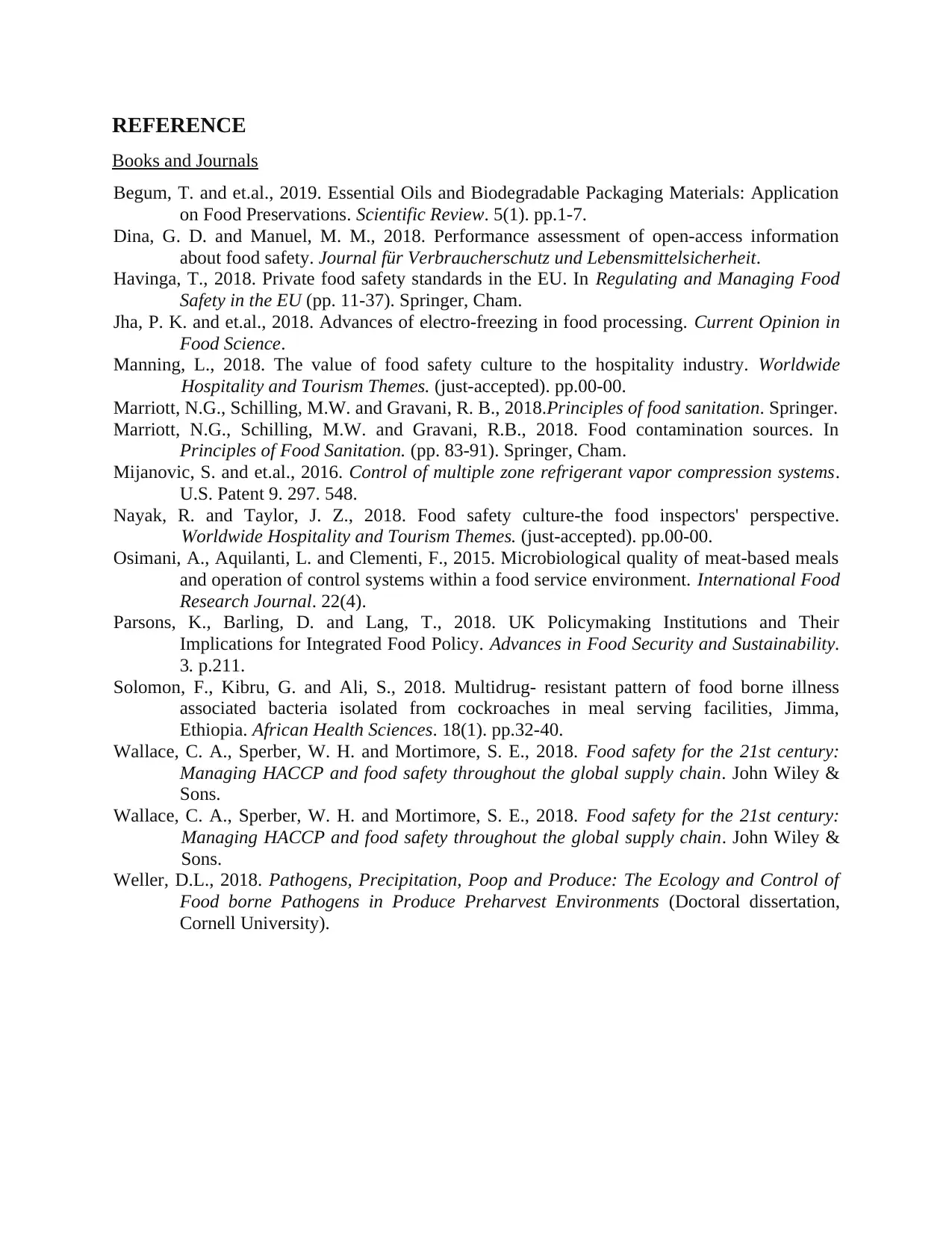
REFERENCE
Books and Journals
Begum, T. and et.al., 2019. Essential Oils and Biodegradable Packaging Materials: Application
on Food Preservations. Scientific Review. 5(1). pp.1-7.
Dina, G. D. and Manuel, M. M., 2018. Performance assessment of open-access information
about food safety. Journal für Verbraucherschutz und Lebensmittelsicherheit .
Havinga, T., 2018. Private food safety standards in the EU. In Regulating and Managing Food
Safety in the EU (pp. 11-37). Springer, Cham.
Jha, P. K. and et.al., 2018. Advances of electro-freezing in food processing. Current Opinion in
Food Science.
Manning, L., 2018. The value of food safety culture to the hospitality industry. Worldwide
Hospitality and Tourism Themes. (just-accepted). pp.00-00.
Marriott, N.G., Schilling, M.W. and Gravani, R. B., 2018.Principles of food sanitation. Springer.
Marriott, N.G., Schilling, M.W. and Gravani, R.B., 2018. Food contamination sources. In
Principles of Food Sanitation. (pp. 83-91). Springer, Cham.
Mijanovic, S. and et.al., 2016. Control of multiple zone refrigerant vapor compression systems.
U.S. Patent 9. 297. 548.
Nayak, R. and Taylor, J. Z., 2018. Food safety culture-the food inspectors' perspective.
Worldwide Hospitality and Tourism Themes. (just-accepted). pp.00-00.
Osimani, A., Aquilanti, L. and Clementi, F., 2015. Microbiological quality of meat-based meals
and operation of control systems within a food service environment. International Food
Research Journal. 22(4).
Parsons, K., Barling, D. and Lang, T., 2018. UK Policymaking Institutions and Their
Implications for Integrated Food Policy. Advances in Food Security and Sustainability.
3. p.211.
Solomon, F., Kibru, G. and Ali, S., 2018. Multidrug- resistant pattern of food borne illness
associated bacteria isolated from cockroaches in meal serving facilities, Jimma,
Ethiopia. African Health Sciences. 18(1). pp.32-40.
Wallace, C. A., Sperber, W. H. and Mortimore, S. E., 2018. Food safety for the 21st century:
Managing HACCP and food safety throughout the global supply chain. John Wiley &
Sons.
Wallace, C. A., Sperber, W. H. and Mortimore, S. E., 2018. Food safety for the 21st century:
Managing HACCP and food safety throughout the global supply chain. John Wiley &
Sons.
Weller, D.L., 2018. Pathogens, Precipitation, Poop and Produce: The Ecology and Control of
Food borne Pathogens in Produce Preharvest Environments (Doctoral dissertation,
Cornell University).
Books and Journals
Begum, T. and et.al., 2019. Essential Oils and Biodegradable Packaging Materials: Application
on Food Preservations. Scientific Review. 5(1). pp.1-7.
Dina, G. D. and Manuel, M. M., 2018. Performance assessment of open-access information
about food safety. Journal für Verbraucherschutz und Lebensmittelsicherheit .
Havinga, T., 2018. Private food safety standards in the EU. In Regulating and Managing Food
Safety in the EU (pp. 11-37). Springer, Cham.
Jha, P. K. and et.al., 2018. Advances of electro-freezing in food processing. Current Opinion in
Food Science.
Manning, L., 2018. The value of food safety culture to the hospitality industry. Worldwide
Hospitality and Tourism Themes. (just-accepted). pp.00-00.
Marriott, N.G., Schilling, M.W. and Gravani, R. B., 2018.Principles of food sanitation. Springer.
Marriott, N.G., Schilling, M.W. and Gravani, R.B., 2018. Food contamination sources. In
Principles of Food Sanitation. (pp. 83-91). Springer, Cham.
Mijanovic, S. and et.al., 2016. Control of multiple zone refrigerant vapor compression systems.
U.S. Patent 9. 297. 548.
Nayak, R. and Taylor, J. Z., 2018. Food safety culture-the food inspectors' perspective.
Worldwide Hospitality and Tourism Themes. (just-accepted). pp.00-00.
Osimani, A., Aquilanti, L. and Clementi, F., 2015. Microbiological quality of meat-based meals
and operation of control systems within a food service environment. International Food
Research Journal. 22(4).
Parsons, K., Barling, D. and Lang, T., 2018. UK Policymaking Institutions and Their
Implications for Integrated Food Policy. Advances in Food Security and Sustainability.
3. p.211.
Solomon, F., Kibru, G. and Ali, S., 2018. Multidrug- resistant pattern of food borne illness
associated bacteria isolated from cockroaches in meal serving facilities, Jimma,
Ethiopia. African Health Sciences. 18(1). pp.32-40.
Wallace, C. A., Sperber, W. H. and Mortimore, S. E., 2018. Food safety for the 21st century:
Managing HACCP and food safety throughout the global supply chain. John Wiley &
Sons.
Wallace, C. A., Sperber, W. H. and Mortimore, S. E., 2018. Food safety for the 21st century:
Managing HACCP and food safety throughout the global supply chain. John Wiley &
Sons.
Weller, D.L., 2018. Pathogens, Precipitation, Poop and Produce: The Ecology and Control of
Food borne Pathogens in Produce Preharvest Environments (Doctoral dissertation,
Cornell University).
1 out of 11
Related Documents
Your All-in-One AI-Powered Toolkit for Academic Success.
+13062052269
info@desklib.com
Available 24*7 on WhatsApp / Email
![[object Object]](/_next/static/media/star-bottom.7253800d.svg)
Unlock your academic potential
Copyright © 2020–2025 A2Z Services. All Rights Reserved. Developed and managed by ZUCOL.





